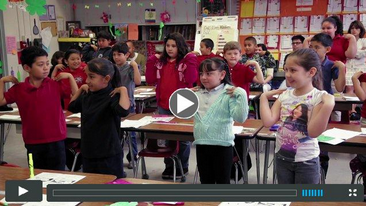By Margaret Broucek

Children’s belief in the reliability of the adults in their lives may be more important than we realize—affecting their short-term decisions and possibly even their future success. In this post, I’m going to explore a classic study on self-regulation in children and new research developments.
On a different but related note, I’ll also share some insights from my work with teachers who use the PAX Good Behavior Game and let you know about a brand-new website to support PAX users and help new users get started in creating a peaceful and productive learning environment.
“Many of the most challenging kids have been let down by the adults in their lives . . . It takes time to gain the trust that the commitment is there.”
The Marshmallow Test
The Stanford “Marshmallow Test” studies dating from the late 1960s are among the best-known and most widely influential psychological studies ever done. In these tests, Stanford professor Walter Mischel and colleagues gave preschool children two options: Eat one marshmallow (or pretzel or cookie) right away, or wait alone for 15 minutes (without eating the treat) and get a second one.
These child participants were then followed over time (some into midlife), and the researchers found correlations between those who could delay gratification and better school performance, less substance abuse, higher SAT scores, and lower body mass measurements, among other findings. These experiments are still going on today, and you can watch many, many YouTube videos showing young participants caressing the marshmallows, sniffing them, licking them, and visibly agonizing over the decision to eat or not to eat.
While a number of these studies link self-control to long-term success, they offer no mechanism for helping young people acquire this skill. Ironically, at the same time—in the late ‘60s—Muriel Saunders, a fourth grade teacher in Kansas, was developing a game that did just that. The Good Behavior Game uses positive peer pressure within teams and quick, intrinsic rewards to reduce disruptive and disturbing behaviors in the classroom. The game too has benefited from longitudinal studies showing that the students who regularly participated in it had a wealth of better outcomes than their peers who didn’t play the game at all.
A New Twist to the Marshmallow Test
A recent study has now added to our understanding of what influences a child’s decision to eat or not eat the marshmallow and throws into question the idea that waiting is always the best and right choice (from the perspective of the child, that is). Celeste Kidd, a graduate student in cognitive science at the University of Rochester, wondered how a child’s environment affected his or her decision regarding the marshmallow. She hypothesized that a child who had learned not to trust adults (which was true of many children that Kidd had worked with in homeless shelters) would eat the marshmallow regardless of whether he or she had the innate ability to wait.
Kidd devised a new version of the test in which children were divided into two groups. The first group interacted with adults who told them they would soon get something better than what they had been given—and then delivered what was promised. The second group was subjected to adults who never delivered on their promises for things, such as better art supplies or stickers. Both groups were then given the Marshmallow Test. The kids in the second group, who had to deal with unreliable adults, overwhelmingly ate the first marshmallow, and they did so in an average of three minutes time. Children in the first group, who had had reliable interactions with adults, waited on average four times longer (12 minutes) than the children in the unreliable situations.
Kidd’s new research suggests that the trust children have in adults—which can be influenced by the behavior of any adults in their lives, including teachers—has a great effect on their decision-making. Delaying gratification in the case of the marshmallow only makes sense to a child if the child believes it is likely that he or she will actually receive the promised award.
Kidd concludes, “It’s incorrect to presume lack of willpower is the only relevant factor in determining children’s wait times and, subsequently, the primary driver of children’s successes later in life.”
PAX Good Behavior Game and Our New Website
Dennis Embry of PAXIS Institute—the developer of the more robust PAX Good Behavior Game, which has been informed by Embry’s previous work on the violence-prevention program PeaceBuilders®—often makes this point to teachers: For all children to benefit from the creation of a wonderful classroom, consistency with the Good Behavior Game is key. Many of the most challenging kids have been let down by the adults in their lives, and they simply won’t trust that the teacher will stay with the game and maintain the classroom intervention strategies that have been set up. It takes time to gain the trust that the commitment is there. To paraphrase a popular movie tagline, “If you build it—and also maintain it—they will come.”
Over the years, schools and classrooms that use the Good Behavior Game have reported a variety of positive outcomes—including a 50–90% reduction in disruptive or disorderly behaviors in the classroom, and a 30–60% reduction in referrals, suspensions, and expulsions. Furthermore, the game has been found to increase student engagement while decreasing teacher stress.
We’re very excited to announce our recent launch of the PAX Good Behavior Game website. If you’re new to PAX, our website will tell you all you need to know about what it is and how to get started. If you’re already using PAX, the site provides video-based professional development and a portal for you to connect with other PAX users to share your experiences and develop new skills. You’ll find many fun, interactive features, such as “Ask Dr. PAX,” where Dr. Embry answers frequently asked questions about PAX, and “Granny’s Wacky Prize Bank”—a searchable prize database.
Your Turn
How have you seen consistency play out in working with challenging children? We’d like to hear about your experiences. We’d also love to hear your thoughts about our new PAX Good Behavior Game website. Please add your thoughts and comments below.*
Don't miss out—sign up to receive our blog, Promote Prevent Perspectives, in a weekly email!
*E-mail addresses will be kept confidential.
